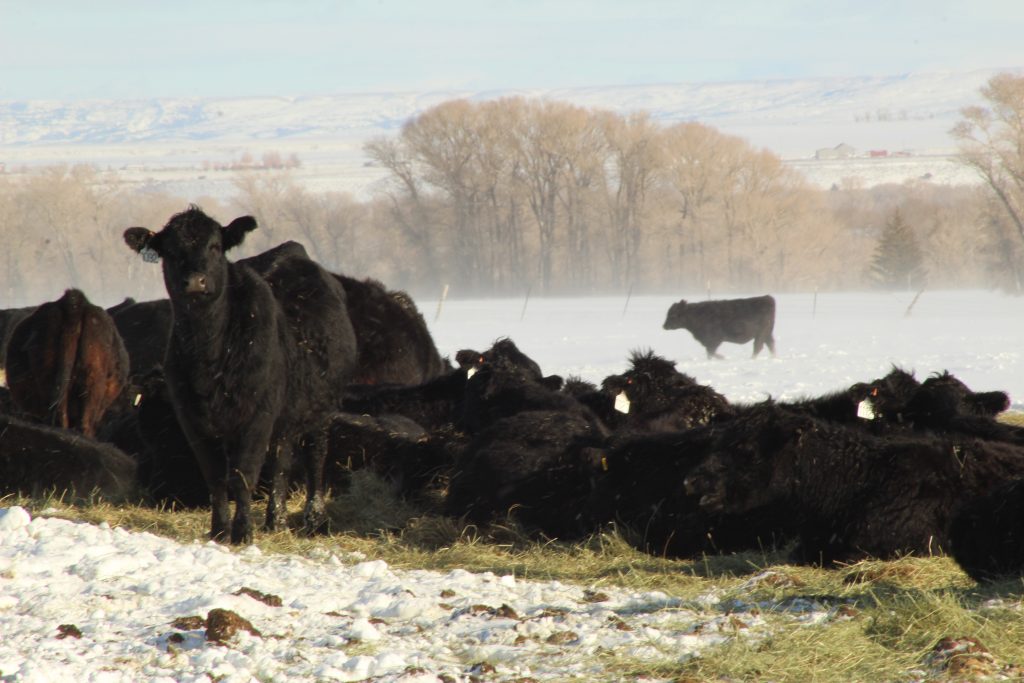Winter Feeding Considerations

UW SAREC Director discusses forage options at WSGA Convention
During the Winter Roundup Convention and Trade Show, held in Casper Dec. 4-6, the Wyoming Stock Growers Association (WSGA) invited Dr. Steve Paisley, director of the University of Wyoming’s (UW) Sustainable Agriculture Research and Extension Center (SAREC), to discuss winter feeding options for cow/calf producers.
Paisley attended UW, where he studied animal science and stayed for his master’s degree, later pursuing a doctorate at Oklahoma State University in ruminant nutrition.
After completing his PhD, Paisley worked at Kansas State University for nearly four years as a beef specialist before returning to UW in 2001, then transferred to SAREC, located in Lingle, in 2007 and has served as the director since 2019.
Understanding forages
Feed efficiency has become increasingly important, and reducing winter feed costs in a cow/calf operation can generate savings for producers.
“The best place to start is with a forage analysis,” Paisley said. “I would encourage you to use a probe and gather a sample from inside the bale, rather than just grabbing a hand sample because we don’t need just the outside of the bale.”
Reviewing the forage analysis report can give a producer a general idea of the protein level and the energy values for the particular forage.
“Remember to test for nitrates. If you have forages susceptible to them, you need to know where the level is at,” Paisley added. “For us, this typically consists of looking at cereal forages such as oat hay, barley hay, wheat hay and sorghum sudan hay.”
Paisley reminded the group some labs test for nitrate nitrogen, while others test for capacity nitrate, so he encouraged producers to ask questions and contact SAREC if they need assistance.
“We can walk producers through the testing results,” he noted.
Paisley further explained, “We can manage feed intake by adjusting and blending diets, but we need to know what we are feeding, so getting and reviewing a forage analysis is an essential step in feed efficiency. Taking into account what facilities and equipment you have can determine how you blend forages.”
“For example, you may own a vertical mixer or you can grind hay and blend two different forages together, or maybe you have the ability to sort cattle and feed them in different groups,” he added.
Because forages vary, it’s good practice to know the characteristics of each forage and balance it with cost efficiency based on the operation’s setup.
“We have to use a protein conversion system to calculate costs per pound. By putting a dollar value with each type of forage, we can calculate how much it will take to meet the cow’s nutritional requirements by blending feeds and remain cost effective,” he continued.
Winter feeding
“Good winter feeding management practices contribute to healthy and productive cattle,” Paisley stated.
“At this time of year, producers have a stockpile of sampled hay and know what high, medium and low quality is,” he continued. “Now, we need to match the forage to the height of requirement. What do we feed early and what do we save for last?”
Paisley explained high-quality forages typically contain 14 to 20 percent protein and include forages such as alfalfa or good-quality oat hay. Sorghum sudan hay is considered a medium-quality forage, and wheat straw and cornstalks are considered lower-quality hay.
Nutrient requirements of cattle change throughout the year based on the stage of the production cycle, age, level of activity, pest load and environment. Therefore, it is imperative for cattle producers to have an adequate understanding of the basic nutrient requirements of the cow herd to make informed and effective nutrition-related decisions.
According to Paisley, if a 1,200-pound cow is expected to calve the first of March, during the last 60 days prior to calving, her energy requirements increase about 20 percent, and once lactation begins, her energy level requirements go up another 30 percent.
“So, this is the time period producers need to feed quality hay, not a high-protein hay. Producers need to look at what they have stockpiled and feed the cow her required protein intake, which is around 10 to 12 percent, as overfeeding high-protein hay will only result in the cow indirectly fertilizing the ground,” he clarified.
He stated, “After weaning, her requirements will be at the lowest point, and she will only need about 1.6 pounds of protein per day. But, as she moves into late gestation, her protein requirements will go up by 20 percent.”
Paisley explained a cow requires protein to maintain muscle mass and internal organ function, and as a rule of thumb, a mature cow needs around seven percent protein in her diet to keep the rumen functioning properly.
“So, if she was grazing a low-quality forage – four to five percent protein – we need to provide a protein supplement,” he stated.
Paisley concluded, “To minimize risk with winter feeding programs, remember to sample forages; stockpile adequate feed, which is calculated in a feed analysis and make better use of forages. Plus, strategically blended forages can help meet a cow’s requirements as she moves through her production year. “
Melissa Anderson is the editor of the Wyoming Livestock Roundup. Send comments on this article to roundup@wylr.net.





